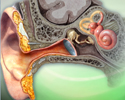Devices for hearing loss
If you are living with hearing loss, you know that it takes extra effort to communicate with others.
There are many different devices that can improve your ability to communicate. This can help reduce stress for you and those around you. These devices can improve your life in numerous ways.
- You can avoid becoming socially isolated.
- You can remain more independent.
- You can be safer wherever you are.
A hearing aid is a small electronic device that fits in your ear or behind it. It amplifies sounds so that you are better able to communicate and participate in everyday activities. A hearing aid has three parts. The sounds are received through a microphone which converts the sound waves into electric signals that are sent to an amplifier. The amplifier increases the strength of the signals and transmits them into the ear through a speaker.
There are three styles of hearing aids:
- Behind-the-ear (BTE). The electronic components of the hearing aid are contained in a hard plastic case that is worn behind the ear. It is connected to an ear mold that fits into the outer ear. The ear mold projects sound from the hearing aid into the ear. In the newer style open-fit hearing aids, the behind-the-ear unit doesn't use an ear mold. Instead it is connected to a narrow tube that fits into the ear canal.
- In-the-ear (ITE). With this type of hearing aid, the hard plastic case holding the electronics fits completely inside the outer ear. ITE hearing aids may use an electronic coil called a telecoil to receive sound rather than a microphone. This makes hearing over the telephone easier.
- Canal hearing aids. These hearing aids are made to fit the size and shape of the person's ear. Completely-in-canal (CIC) devices are mostly hidden in the ear canal.
An audiologist will help you choose the proper device for your hearing needs and lifestyle.
Assistive Listening Devices
When many sounds are all mixed together in a room, it is harder to pick up the sounds you want to hear. Assistive technology helps people with hearing loss understand what is being said and communicate more easily. These devices bring certain sounds directly to your ears. This can improve your hearing in one-on-one conversations or in classrooms or theaters. Many listening devices now work through a wireless link and can connect directly to your hearing aid or cochlear implant.
Types of assistive listening devices include:
- Hearing loop. This technology involves a thin loop of wire that circles a room. A sound source such as a microphone, public address system, or home TV or telephone transmits amplified sound through the loop. The electromagnetic energy from the loop is picked up by a receiving device in the hearing loop receiver or a telecoil in a hearing aid.
- FM systems. This technology is often used in classrooms. It uses radio signals to send amplified sounds from a small microphone worn by the instructor, which is picked up by a receiver that the student wears. The sound can also be transmitted to a telecoil in a hearing aid or cochlear implant by way of a neck loop the person wears.
- Infrared systems. Sound is converted into light signals which are sent to a receiver that the listener wears. As with FM systems, people who have hearing aids or an implant with a telecoil can pick up the signal via a neck loop.
- Personal amplifiers. These units consist of a small box about the size of a cell phone that amplifies sound and reduces background noise for the listener. Some have microphones that can be placed near the sound source. The enhanced sound is picked up by a receiver such as a headset or earbuds.
Alerting Devices
Alerting devices help make you aware of sounds, such as the doorbell or a ringing phone. They can also alert you to things happening nearby, such as a fire, someone entering your home, or your baby's activity. These devices send you a signal that you can recognize. The signal may be a flashing light, a horn, or a vibration.
Devices for the Telephone
There are many tools that can help you listen and talk on the telephone. Devices called amplifiers make sound louder. Some phones have amplifiers built-in. You can also attach an amplifier to your phone. Some can be carried with you, so you can use them with any phone.
Some amplifiers are held next to the ear. Many hearing aids work with these devices but may require special settings.
Other devices make it easier to use your hearing aid with a digital phone line. This helps prevent some distortion.
Telecommunication relay services (TRS) allow people with severe hearing loss to place calls to standard telephones. Text telephones, called TTYs or TTDs, allow the typing of messages through a phone line rather than using voice. If the person on the other end can hear, the typed message is relayed as a voice message.
References
National Institute on Deafness and Other Communication Disorders (NIDCD) website. Assistive devices for people with hearing, voice, speech, or language disorders. www.nidcd.nih.gov/health/assistive-devices-people-hearing-voice-speech-or-language-disorders. Updated November 12, 2019. Accessed June 13, 2023.
National Institute on Deafness and Other Communication Disorders (NIDCD) website. Hearing aids. www.nidcd.nih.gov/health/hearing-aids. Updated October 11, 2022. Accessed June 13, 2023.
Stach BA, Ramachandran V. Hearing aid amplification. In: Flint PW, Francis HW, Haughey BH, et al, eds. Cummings Otolaryngology: Head and Neck Surgery. 7th ed. Philadelphia, PA: Elsevier; 2021:chap 164.
Review Date: 6/4/2023
Reviewed By: Josef Shargorodsky, MD, MPH, Johns Hopkins University School of Medicine, Baltimore, MD. Also reviewed by David C. Dugdale, MD, Medical Director, Brenda Conaway, Editorial Director, and the A.D.A.M. Editorial team.


